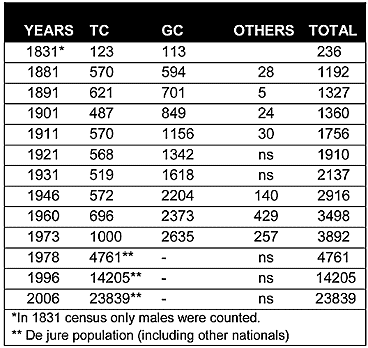
Kyrenia is situated on the northern coast of Cyprus, eleven miles north of the capital city of Nicosia. It was a mixed town until 1974. It was/is also the administrative centre of Kyrenia district. The name of the town was always Κερύνεια for Greek Cypriots and Girne (in the earlier periods Geriniye) for Turkish Cypriots. The meaning of the name is obscure, but some trace its origin to as early as 1000 BC. It always had a functioning harbor that throughout the Ottoman and British periods mostly served trade with Anatolia. By the end of the British period, the harbor had become primarily a center for fishing boats and sponge hunters. Since 1960, the harbor has mainly been used for docking yachts and as a tourism center.

In 1973 the town’s Greek Cypriots constituted the clear majority (almost 67% in 1973 census). This was not the case in the nineteenth century, but the town’s Greek population ratio had grown throughout the twentieth century. According to the 1831 Ottoman census, Muslims constituted the majority at 52%. By 1881, three years into the British administration of the island, Muslims and Christians in the town were still in almost equal numbers, and the census for that year records the town's population as 570 Muslims and 594 Christians. However, a significant Muslim emigration from the town to Anatolia took place between this date and 1931, reducing the Muslim population ratio to only 36% in 1901, 32.5% in 1911, 30% in 1921, and 24% in 1931. One explanation for this exodus may be the general anxiety that prevailed among the island’s Muslim population during the Balkan and First World wars, when the Ottomans fought against Greece in the former and Britain in the latter. Proclamation of the island as a British colony in 1924 caused further Turkish Cypriot emigration to Anatolia. The Turkish Cypriot population ratio continued to decrease until 1960 (20%). Since the end of the Second World War, Kyrenia has also been an important destination for the British expat community. In 1960, the town was a home for almost 429 permanent foreign residents.
Displacement:
During the most turbulent period of the intercommunal fights (1963-1974), unlike many other Turkish Cypriot settlements, Turkish Cypriots continued to stay in the town, but remained mainly confined within their neighborhood. UNFCYP had a regular operation there between 1964 and 1976. Most of the town’s Greek Cypriot inhabitants were displaced in 1974, when in late July they fled from the advancing Turkish army to the southern part of the island. Then again, some Greek Cypriot residents attempted to remain in the town after August 1974. A few of those who tried to remain were kept in the Dome Hotel until October 1975, after which they were taken to Belapais(214) village. In November 1975, the number of those who were enclaved in the town was 163. That number dropped to 95 in February 1976, 48 in May and only 18 in August, 16 in January 1977 and 13 in January 1978. By September 1978, only 7 Greek Cypriots (including two Maronites and two Greek Cypriots who were married to Turkish Cypriots) lived in Kyrenia. Currently, like the rest of the displaced Greek Cypriots, the Greek Cypriots of Kyrenia are scattered throughout the island’s south, with some small pockets in towns. The number of Kyrenian Greek Cypriots displaced between 1974 and 1978 was around 2,650 (2,635 in 1973 census).
Current Inhabitants:
In 1975, in addition to the existing Turkish Cypriot population, the town was repopulated by displaced Turkish Cypriots from the port city of Limassol(269)in the south and some villages of Limassol and Paphos districts (i.e., Polis(332), Kidasi/Jiaz(Ceyhan)(310), Tera/Çakırlar(339), Lempa/Çıralı(317), Vretsia/Dağaşan(342), Pelathousa/Karaağaç(330), Souskiou/Susuz(337), Geroskipou/Yeroşibu(306). Over the last thirty years, many European citizens, wealthy Turks and Turkish Cypriots from elsewhere in the island’s north have also bought property, built houses, and settled there. Due to the recent construction boom and the development in tourism, the town also hosts many immigrant workers from Turkey, Eastern European, Central Asia and Pakistan, who work in these sectors. The 2006 Turkish Cypriot census gives the town’s population as 23,839, but this figure can rise to 30,000 during holidays and tourist season.
Websites: